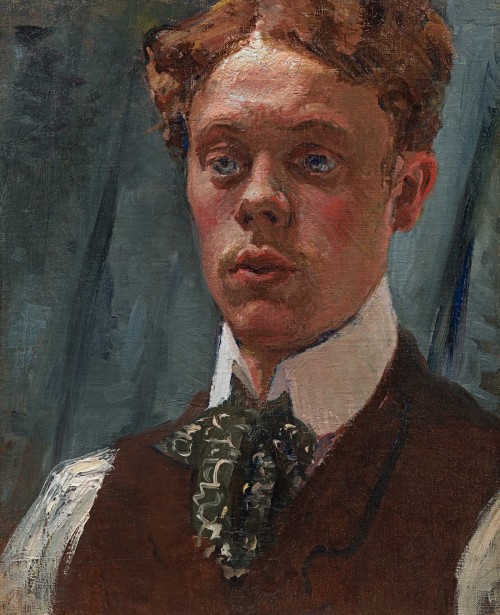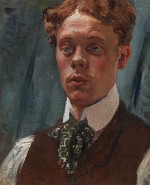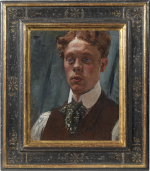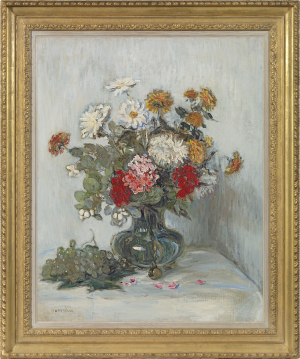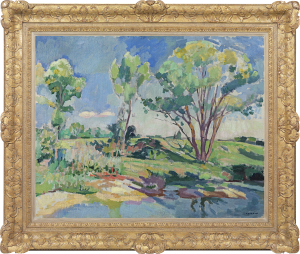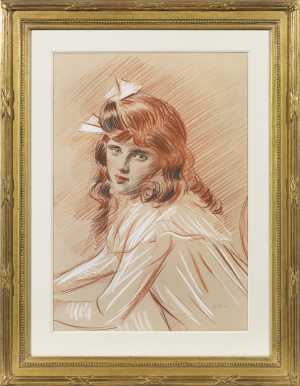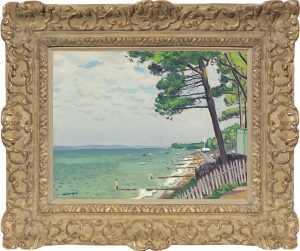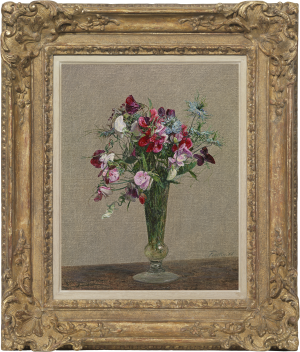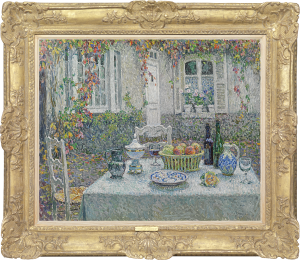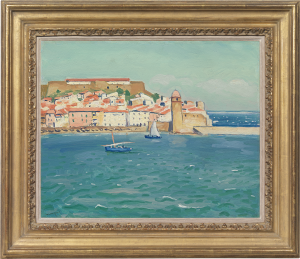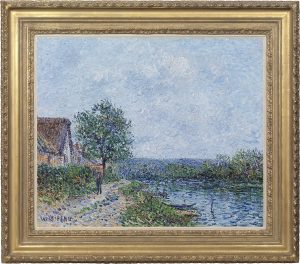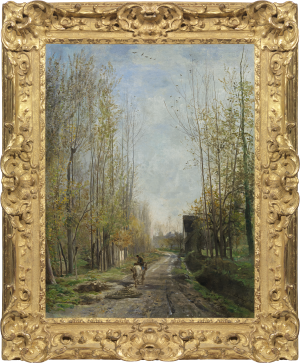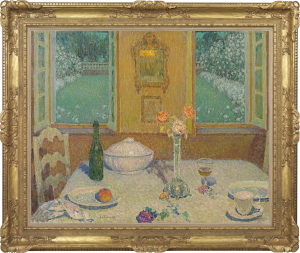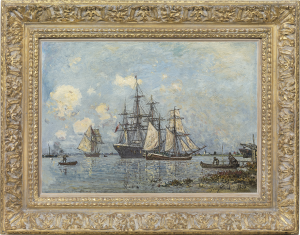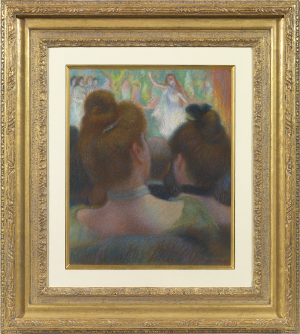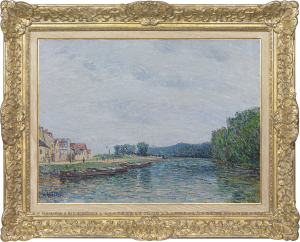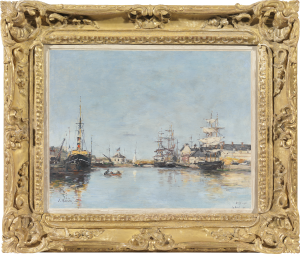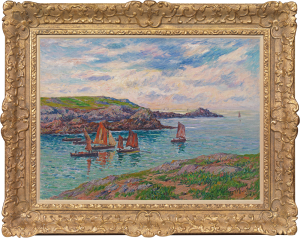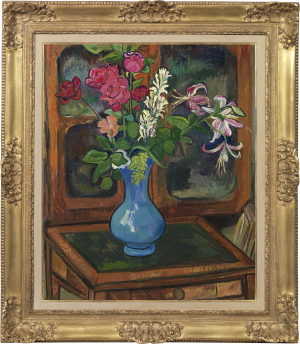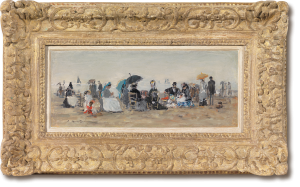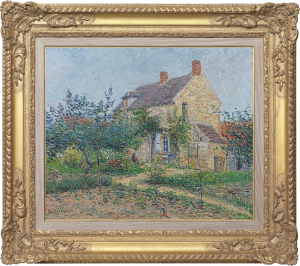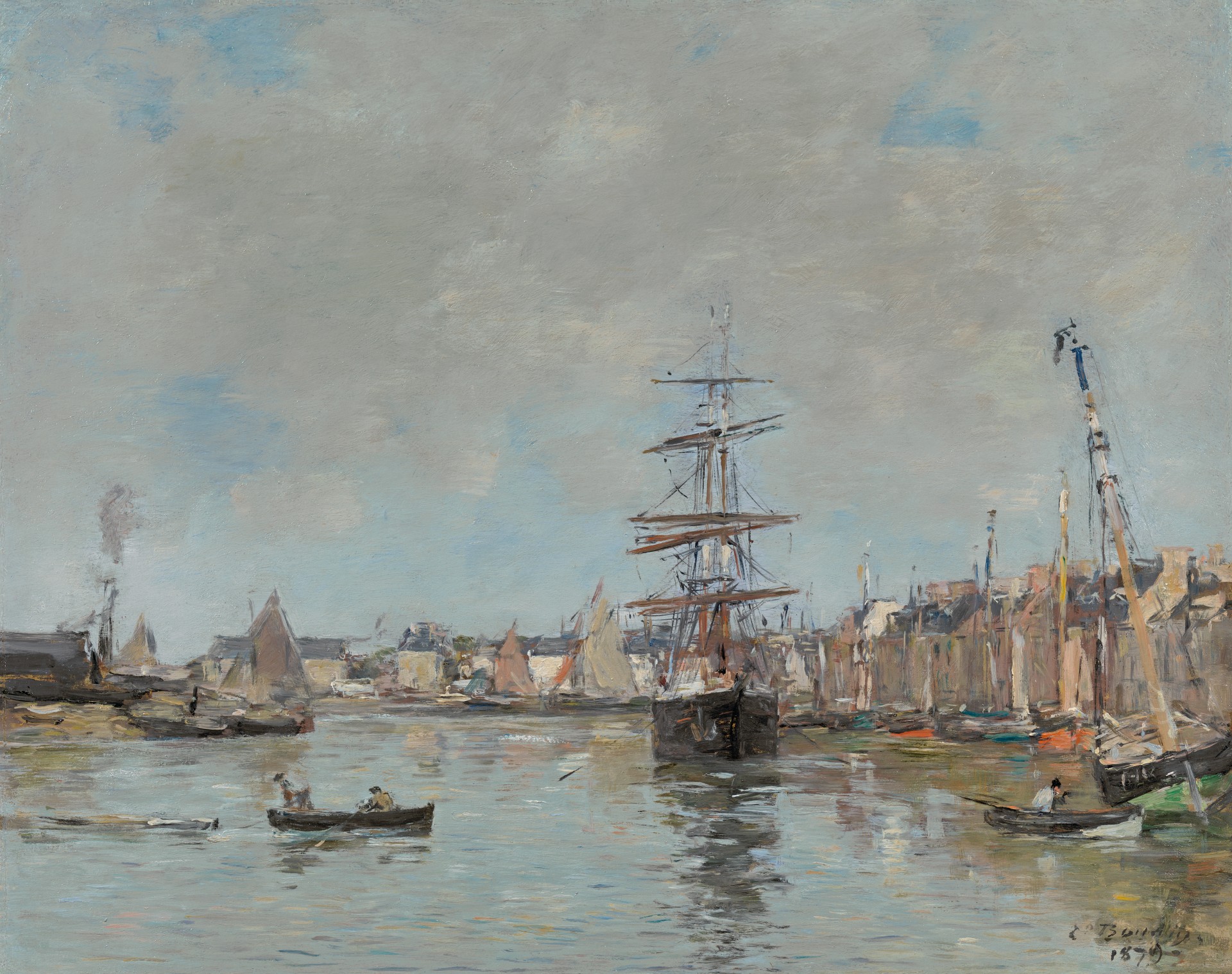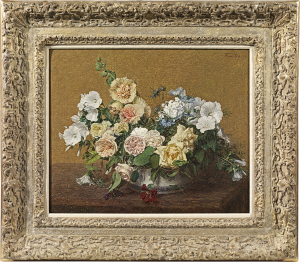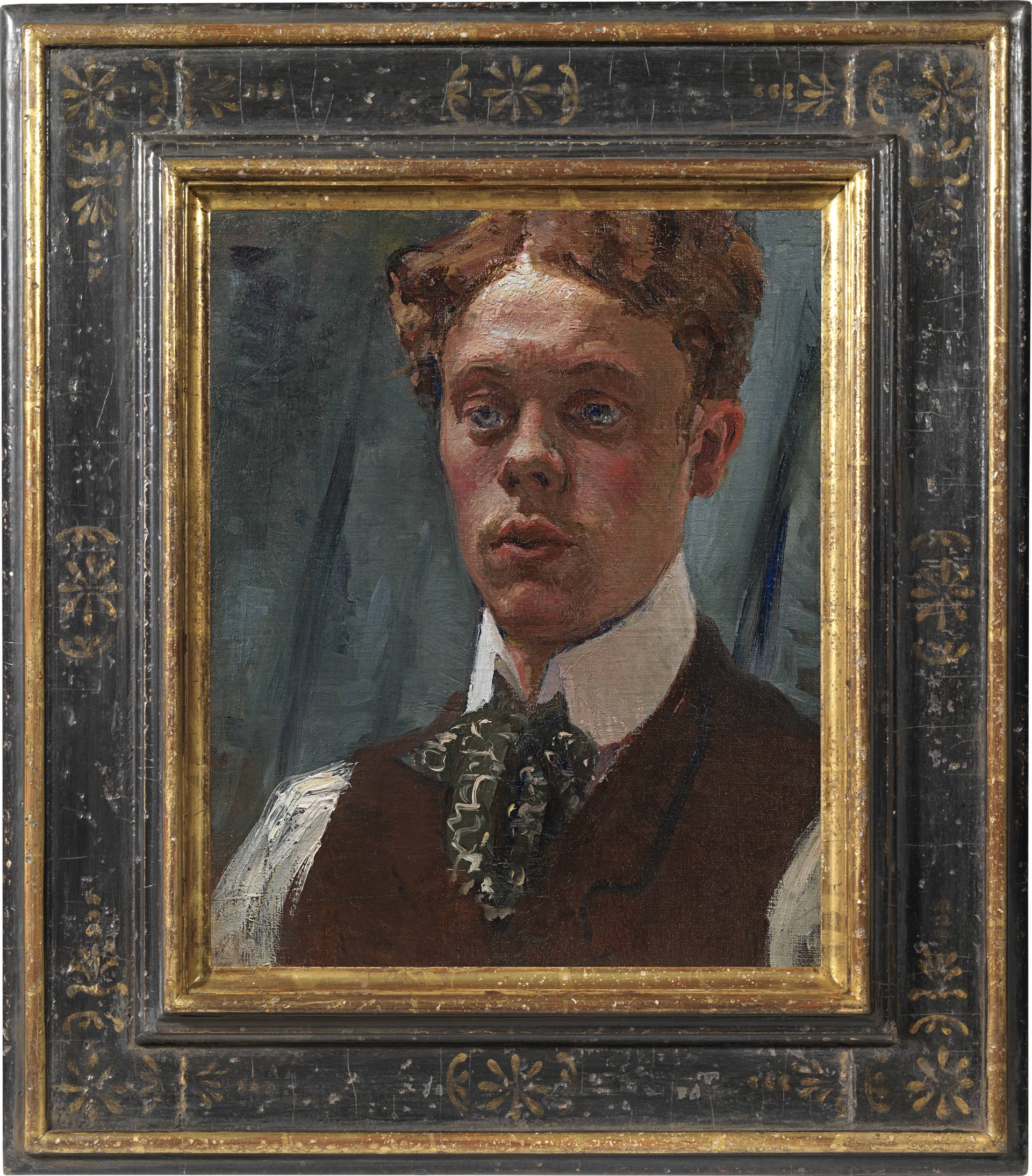Raoul Dufy
Self portrait
Oil on canvas: 15.2 x 12.5 (in) / 38.7 x 31.8 (cm)
Stamped with the signature on the original backboard: Raoul Dufy
This artwork is for sale.
Please contact us on: +44 (0)20 7493 3939.
Email us
RAOUL DUFY
Le Havre 1877 - 1953 Forcalquier
Ref: CA 159
Self-portrait
Stamped with the signature on the original backboard:
Raoul Dufy Oil on canvas: 15 ¼ x 12 ½ in / 38.7 x 31.8 cm
Frame size:
In an antique Italian/Spanish cassetta black and gold frame
Painted in 1897
Provenance:
Bequeathed by Mme Raoul Dufy (1880-1962) to the artist’s friend and executor Monsieur Joseph Reynier (handwritten label on the reverse);
by descent in a private collection, France
Exhibited:
Paris, Galerie Bernheim-Jeune-Dauberville, Chefs d’oeuvre de Raoul Dufy, 1959, no.1
Literature:
Raymond Cogniat, Raoul Dufy, Paris 1967, p.3, illus. in colour as the frontispiece
Maurice Laffaille, Raoul Dufy, Catalogue raisonné de l’œuvre peint, Geneva 1972, vol. I, p.18, no.6, illus.
Mme Fanny Guillon-Laffaille has confirmed the authenticity of this painting (certificate no.P22-9669)
This arresting Self-portrait by the twenty-year-old Raoul Dufy, executed in 1897, stands in a long tradition of youthful self-portraits, from Raphael’s calm classicism to Samuel Palmer’s questing intensity. It is at once a search for identity, a statement of identity and a technical challenge.
Dufy grew up in Le Havre, one of nine children. His father Léon, an accountant in a metal works, was a talented organist and conductor and Raoul inherited his love of music. Despite a sound education which included Latin, Greek, German and drawing, financial difficulties forced Raoul to leave school at fourteen and take a job as an accounts clerk at Luthy and Hauser, an importer of Brazilian coffee. He pursued his passion for art at evening classes at the Ecole Municipale des Beaux-Arts, taught by Charles Lhullier, a pupil of Cabanel. Only in 1900, when he won a scholarship to the Ecole des Beaux-Arts in Paris, was Dufy free to paint full-time.
This Self-portrait reflects the sound draughtsmanship which Dufy had learned from Lhullier, who was described as ‘a real artist, a great classical draughtsman’[1]. He explores the planes of his own face, giving a structural solidity to his features, while treating his torso and clothing more summarily. The pattern on his necktie is evoked in exuberant loops, not only giving life to the lower half of the canvas, but presaging the sinuous delight in line in Dufy’s mature works.
Equally apparent is the future Fauvist’s interest in light and colour. Dufy frames his face in a stiff white collar that throws light upon his features. His ruddy complexion is described with brio and the translucent skin of his ear is a masterly confection of pink and red tones. He uses tiny swirls of black, sapphire and white to give his prominent blue eyes a glittering intelligence as, in a mirror, he dissects the contours of his being. A candid portrait as well as a manifesto of painterly ambition, this work vividly conjures up the young artist recalled by Dufy’s friend, the poet Fernand Fleuret: ‘with his fresh complexion, his head in the air, with his blond curly hair, his protruding sky-blue eyes, dashing, flirtatious and busy’[2].
Self-portraits are rare in Dufy’s oeuvre. Twelve are currently known, of which seven date from around 1897-8[3]; the rest are from the end of Dufy’s life, 1945-50. They include two Self-portraits of 1898 in the Musée National d’Art Moderne, Centre Pompidou, Paris, in one of which Dufy wears the loose collar and cravat of a Romantic poet, and in the other a hat tipped at a jaunty, dandified angle[4]. The present work is perhaps the most fully realized of the group of early self-portraits. It remained in Dufy’s possession and was bequeathed by his widow Emilienne (1880-1962) to Raoul’s friend and executor, Joseph Reynier, in whose family the Self-portrait has descended.
Raoul Dufy, Self-portrait, 1898. Oil on canvas: 17 ¾ x 14 ½ in / 45 x 37 cm.
Musée National d’Art Moderne, Centre Pompidou, Paris.
RAOUL DUFY
Le Havre 1877 - 1953 Forcalquier
Raoul Dufy’s beginnings were marked by his curiosity towards art in general and his love for painting and music. In his leisure time from his work as a book-keeper he took evening courses at the Ecole des Beaux-Arts in Le Havre and constantly visited the museums. He formed a close friendship with another young artist, Othon Friesz, and both men were influenced by Eugène Boudin and Jean-Baptiste-Camille Corot.
In 1900 Dufy joined Friesz in Paris, studying at the Ecole des Beaux-Arts in the studio of Léon Bonnat and encountering the work of Claude Lorrain and the Impressionists. In 1902, the painter Maurice Delcourt introduced Dufy to Berthe Weil, who had a studio in rue Victor Massé. Here she organised exhibitions of avant-garde artists such as Marquet and Matisse. The presence of the Fauve painters at the 1905 Salon des Indépendents proved a revelation. Dufy was particularly impressed by Matisse’s Luxe, calme et volupté, adopting the Fauves’ glowing colours and sweeping brushstrokes in works such as Rue pavoisée, 1906 (Pompidou, Paris).
A visit to Munich in 1909 exposed Dufy to the work of the German Expressionists and the possibilities of wood engraving. The following year he made woodcuts to illustrate Guillaume Apollinaire’s Bestiaire ou cortège d’Orphée and in 1911 established with the fashion designer Paul Poiret La Petite Usine, a cloth-printing workshop in which Dufy produced watercolour designs for Bianchini-Férier textiles.
From the early 1920s Dufy developed his characteristic style, in which free, dynamic drawing is coupled with an arbitrary use of colour independent of line, creating a tremendous sense of joie de vivre. Slavish truth to nature was less important than evoking a ‘shorthand of the essential’ through a poetic universe of emblems. Favourite themes included regattas and seaside views bustling with people, and horse-racing. Dufy travelled in Italy, Morocco and southern France in the 1920s; in the 1930s he often stayed in England, where his work was highly regarded.
Dufy’s first stage design was for the celebrated Le Boeuf sur le Toit (1920), with words by Jean Cocteau and music by Darius Milhaud. He produced designs for ceramics, tapestry cartoons and architectural decorations, notably the 600 sq. metre Electricity fairy (Musée d’Art Moderne de la Ville de Paris), made for the 1937 Exposition Internationale des Arts et Techniques dans la Vie Moderne. Passionate about music, from 1942 Dufy made a series of orchestra paintings. Towards the end of his life he abandoned colour contrasts in favour of almost monochrome tonal painting in such works as Yellow console of the violin, 1949 (Art Gallery of Ontario, Toronto). Raoul Dufy died in Forcalquier, Basses-Alpes, on 23rd March 1953.
The work of Raoul Dufy is represented in the Musée d’Orsay, Paris; the Musée d’Art Moderne de la Ville de Paris; the Musée des Beaux-Arts, Nice; the Hermitage, St Petersburg; Tate Modern, London; the Royal Collection, London; the Metropolitan Museum of Art, New York; the Art Institute of Chicago and the Art Gallery of Ontario, Toronto.
[1] Quoted in London, Arts Council, Hayward Gallery, Raoul Dufy 1877-1953, 1983-4, exh. cat. by Bryan Robertson et. al., p.2.
[2] Fleuret, Eloge de Raoul Dufy, Paris 1931, p.1, quoted in Dora Perez-Tibi, Dufy, London 1989, p.15.
[3] Laffaille, op. cit., vol. I, pp.17-19, no.3-9.
[4] Laffaille, ibid., no.8 and 9.

